GDPR Compliance Checklist: Ensuring Your Software Meets European Standards
Understanding GDPR Compliance
The General Data Protection Regulation (GDPR) has set a new standard for data protection and privacy in the European Union. For software companies, ensuring GDPR compliance is crucial not only for maintaining customer trust but also for avoiding hefty fines. If your software processes personal data of EU citizens, it must adhere to GDPR regulations.
Compliance involves more than just having a privacy policy in place. It requires a thorough evaluation of how data is collected, processed, stored, and shared. Below is a checklist to guide you through the essential steps of ensuring your software meets European standards.

Data Collection and Processing
Lawful Basis for Processing
One of the first steps is to ensure that any data collection and processing have a lawful basis. GDPR defines six lawful bases, including consent, contract performance, and legitimate interests. Identify and document the appropriate basis for each data processing activity.
Obtain Informed Consent
When relying on consent, make sure it is freely given, specific, informed, and unambiguous. Users should have the ability to withdraw consent as easily as they give it. Ensure that your software includes clear consent mechanisms and records consent comprehensively.

User Rights and Data Management
Facilitating User Rights
GDPR grants numerous rights to individuals over their personal data, including the right to access, rectify, erase, and restrict processing. Your software should provide features that allow users to easily exercise these rights. Implement simple processes for handling data requests efficiently.
Data Minimization and Retention
Adopt a data minimization approach by collecting only the data necessary for your specified purposes. Define data retention policies to ensure that personal data is not held longer than necessary. Regularly review and delete data that is no longer required.

Security Measures
Implement Robust Security Protocols
Strong security measures are essential to protect personal data against breaches. Utilize encryption, pseudonymization, and other security technologies to safeguard data. Conduct regular security assessments and updates to address vulnerabilities promptly.
Breach Notification Procedures
In the event of a data breach, GDPR requires prompt notification to relevant authorities and affected individuals within 72 hours. Establish a comprehensive breach response plan outlining roles, responsibilities, and communication strategies to ensure swift action.

Documentation and Accountability
Maintain Detailed Records
Keeping detailed records of processing activities is a vital aspect of GDPR compliance. Document what personal data you collect, why it is collected, how it is processed, and who has access. These records demonstrate accountability and transparency to regulators.
Regular Compliance Audits
Conduct regular audits to assess compliance with GDPR requirements. Audits help identify potential gaps and areas for improvement. Engage with legal experts or consultants to ensure your practices align with the latest guidelines and maintain compliance over time.

By following this GDPR compliance checklist, software companies can better align their operations with European standards and protect the personal data of their users. Staying informed about ongoing regulatory updates and investing in robust data protection practices will further enhance compliance efforts.
